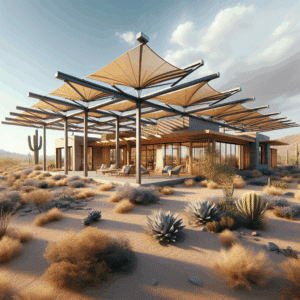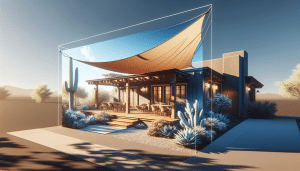Living in the Valley of the Sun comes with a pretty obvious caveat: the sun doesn’t play fair. If you’ve ever burned your hand on a door handle in July or watched your patio furniture fade into oblivion, you know exactly why finding the right shade solution isn’t just a luxury—it’s a survival tactic for your backyard.
Contents
- 1 Wait, Is It Just About Blocking the Sun?
- 2 Analyzing the Materials (Or Why Cheap Fabric Fails)
- 3 The Geometry of Shade: It Moves!
- 4 Let’s Talk Installation (And Why Soil Matters)
- 5 The Regulatory Maze: HOAs and Permits
- 6 Designing for Lifestyle: What Are You Covering?
- 7 The Cost-Benefit Reality
- 8 Maintenance: Keep It Tight
- 9 Why Professional Installation Wins
- 10 Ready to Reclaim Your Backyard?
Wait, Is It Just About Blocking the Sun?
You might think grabbing a generic umbrella from a big-box store is enough, but let’s be real for a second. Have you ever chased one of those umbrellas across the yard during a monsoon? It’s not fun.
When we talk about patio shade in Phoenix, we are dealing with a unique beast. It’s not just about blocking light; it’s about managing heat load and UV exposure. We’re trying to create a pocket of cool air, or what pros call a microclimate. If you do it right, you can actually drop the temperature beneath the shade by 15 to 20 degrees.
That is the difference between enjoying a BBQ in Gilbert and retreating inside to the A/C because your burger is cooking just by sitting on the plate.
When you start looking for options, you generally run into three main contenders:
- Pergolas: The classic wood or aluminum structures. They look great but can be pricey and sometimes require serious maintenance.
- Retractable Awnings: Good for flexibility, but they can be fragile in high winds.
- Shade Sails: These are increasingly popular in places like Scottsdale and Chandler because they offer that modern, architectural look while being incredibly effective at UV blocking.
Analyzing the Materials (Or Why Cheap Fabric Fails)
Here’s the thing about materials. You can go online right now and find a “shade sail” for fifty bucks. Honestly? Don’t do it. In the Arizona climate, that cheap fabric will disintegrate faster than a snow cone on the sidewalk.
You need to look for High-Density Polyethylene (HDPE) mesh fabric. Why? Because unlike solid canvas, HDPE breathes. It allows hot air to rise through the fabric rather than getting trapped underneath it. If you use a waterproof material (like canvas or PVC) in a hot climate, you are essentially creating a heat trap. You’ll be shaded, sure, but you’ll be sweating.
Key Specs to Watch For
When you are looking at quotes or samples, keep an eye on these terms:
| Term | What It Means | Why It Matters in AZ |
|---|---|---|
| GSM (Grams per Square Meter) | The weight/density of the fabric. | Higher GSM (300+) means it won’t tear in a haboob. |
| UV Block % | Percentage of ultraviolet rays blocked. | Aim for 90-98%. This protects your skin and your furniture. |
| Stitched vs. Heat Sealed | How the seams are joined. | PTFE thread (like Gore-Tex) resists UV rot; heat sealing is even stronger. |
Waterproof shade sails do have their place, usually over outdoor kitchens or expensive electronics where rain protection is critical. But for general seating areas in Mesa or Tempe, breathable mesh is the champion.
The Geometry of Shade: It Moves!
This sounds obvious, but you’d be surprised how many people install a structure based on where the sun is at noon. But the sun moves. Shocking, I know.
If you install a square shade directly over your table, by 4:00 PM—when you actually want to use the patio for happy hour—the shade might be cast entirely on your neighbor’s fence, leaving you squinting in the glare.
You have to track the sun’s path. In the winter, the sun is lower in the southern sky. In the summer, it’s almost directly overhead but tracks slightly north.
Pro Tip: We often use a hypar Design for shade sails. That’s short for hyperbolic paraboloid. It basically means twisting the fabric by setting mounting points at different heights (two high, two low).
Why do this? Two reasons:
- Visuals: It looks architecturally stunning, like a piece of art.
- Tension: A flat piece of fabric sags. A twisted piece stays tight. Tight fabric doesn’t flap in the wind, which extends the lifespan of the material significantly.
Let’s Talk Installation (And Why Soil Matters)
Okay, so you’ve picked your spot. Now comes the hard part. If you are considering the DIY route, I need to give you a heads-up about the ground beneath your feet.
If you live in the East Valley, you are likely sitting on top of Caliche. If you aren’t familiar, Caliche is essentially sedimentary rock that thinks it’s concrete. Digging a hole for a 4×4 post isn’t a shovel job; it’s a jackhammer job.
The Importance of Footings
For a tension structure like a shade sail, the forces are massive. We aren’t just holding the weight of the fabric; we are holding the wind load. During a monsoon, that sail acts like… well, a sail. It wants to take off.
If your Posts aren’t anchored deep enough, the wind will leverage them right out of the ground.
- Steel Posts: You generally want schedule 40 steel pipe. Wood posts can warp over time under the constant tension, leading to a saggy shade.
- Concrete Depth: We usually dig footings that are at least 3 to 4 feet deep, depending on the size of the sail.
- Lean Back: Often, posts are installed with a slight lean away from the center. As we tighten the turnbuckles, the post flexes slightly into the correct position, keeping constant tension on the fabric.
It’s a bit of physics and a bit of brute force.
The Regulatory Maze: HOAs and Permits
You know what’s less fun than digging in Caliche? Dealing with paperwork. But if you skip this, you might end up tearing your beautiful new shade down.
Every city has different rules. Scottsdale tends to be strict about setbacks (how close you can build to the property line). Gilbert and Chandler have their own quirks regarding structure height.
And then there is the HOA.
Most HOAs in Arizona restrict “temporary” structures. This is why professionally installed shade sails are often easier to get approved than a pop-up gazebo. They are considered permanent improvements. However, you usually need to submit a plot plan showing the Colors and heights. Stick to earth tones—desert sand, terracotta, slate gray. Bright blue might look like a swimming pool, but your HOA board will probably hate it.
Designing for Lifestyle: What Are You Covering?
Let’s shift gears back to the fun stuff. How do you actually use your yard?
I’ve seen people cover their entire pool. While that keeps the water cold (sometimes too cold), it can be overkill. You might want cantilevered shade that covers just the Baja step or the shallow end where the kids play.
For dining areas, ensure the shade structure extends at least 2-3 feet past the edge of the table on all sides. This accounts for that late-afternoon sun angle we talked about earlier.
Don’t Forget the Cars
It’s not just about patios. In driveway-heavy neighborhoods in Mesa, carport Shade Structures are huge. Parking under shade preserves your car’s paint and dashboard, and it keeps you from burning your legs on leather seats. A simple cantilever structure can protect two vehicles without requiring a bunch of posts that you might accidentally back into.
The Cost-Benefit Reality
Is a custom shade structure cheap? Not necessarily. But compared to building a solid roof extension on your house, it is a fraction of the cost.
Think about the value. You are essentially adding square footage to your home. If your patio is unusable for five months of the year, that’s dead space. By adding effective shade, you reclaim that footage.
Plus, there is the energy factor. Shading the windows and sliding glass doors of your home prevents solar heat gain inside. That means your air conditioner doesn’t have to work as hard, which—given our utility bills in August—is a win for your wallet.
Maintenance: Keep It Tight
Once your shade is up, you can’t just forget about it forever. Fabrics stretch. Hardware settles.
Every spring, you should check the turnbuckles. These are the metal screws that connect the sail to the mount. Give them a few turns to tighten the fabric back up. Remember, a tight sail is a happy sail. Loose fabric whips in the wind, causing friction that wears down the fibers.
Cleaning is simple. Usually, a garden hose and some mild dish soap are all you need. Don’t use a high-pressure power washer; you might blast the UV coating right off the fibers. And please, for the love of your shade, keep tree branches trimmed back. A bougainvillea rubbing against a shade sail will chew through it in a single season.
Why Professional Installation Wins
I’m all for DIY projects. Painting a room? Go for it. Planting a cactus? Sure. But tension shade structures are dangerous if they fail. The amount of stored energy in a tensioned cable is high. If a mounting point pulls out of the wall because it wasn’t anchored to a stud or a masonry bond beam, it can cause serious damage or injury.
Professionals use laser levels to get the heights right for water runoff. We know which masonry anchors hold in cinder block versus stucco over frame. We know how to calculate the wind load so your shade stays put when the sky turns dusty and gray.
Ultimately, you want a shade solution that looks like it belongs there, not something jerry-rigged with rope and hope.
Ready to Reclaim Your Backyard?
It’s time to stop hiding indoors and start enjoying the beautiful outdoor living space you paid for. Whether you need a sleek shade sail for your pool area or a robust structure for your driveway, getting the right design and installation is crucial for longevity and safety.
Don’t let another summer go by with a roasting hot patio. Call Arizona Shade Sails today at 480-418-8438 to discuss your options. Request a Free Quote now and let’s get some cool shade over your head before the heat kicks in.




